Abstract
To clarify the influence of aSargassum forest on water temperature distributions observations were made inside and outside aSargassum forest off the Nagata Shore on the northern Saiki Bay open to the Bungo Channel on the Pacific side of Kyushu, Japan. About sixty thermistor probes were deployed at 0.5 m depth intervals from the bottom to the sea surface at seven stations spaced at 50–80 m distances along two transects: one inside the forest and the other outside. Water temperature was measured at five minutes intervals from 6 to 9 August 1987 with thermistor probes. The spatial standing crop distribution of theSargassum forest along the transects was investigated. A water temperature jump of about 2°C, recorded during the observation, is probably caused by an intrusion of a warm water mass from the central Bungo Channel to Saiki Bay. The water temperature jump under theSargassum forest on the rough bottom with stones occurred one to two hours behind that outside the forest (sandy bed) although the distance between the transects inside and outside the forest was only 50–80 m. It is suggested that theSargassum forest and the rough bottom would prevent intruding warm water from smoothly replacing cold water due to resistance of theSargassum species and the bottom to a current.
Similar content being viewed by others
References
Jackson, G. A. (1977): Nutrients and production of giant kelp,Macrocystis pyrifera, off southern California.Limnol. Oceanogr.,22, 979–995.
Jackson, G. A. and C. D. Winant (1983): Effect of a kelp forest on coastal currents.Cont. Shelf Res.,2, 75–80.
Komatsu, T. (1985): Temporal fluctuation of water temperature in aSargassum forest.J. Oceanogr. Soc. Japan,41, 235–243.
Komatsu, T., H. Ariyama, H. Nakahara and W. Sakamoto (1982): Spatial and temporal distributions of water temperature in aSargassum forest.J. Oceanogr. Soc. Japan,38, 63–72.
North, W. J. and R. C. Zimmerman (1984): Influences of macronutrients and water temperatures on summertime survival ofMacrocystis canopies.Hydrobiologia,116/117, 419–424.
Takeoka, H. (1988): Physical environments. Characteristics of Uwajima Bay and conservation of aquacultural environments. p. 54–71. InResearch Report of Special Educational Fund by Ehime University in 1988, ed. by T. Yanagi, Ehime University, Matsuyama, Ehime (in Japanese).
Takeoka, H. and T. Yoshimura (1988): The Kyucho in Uwajima Bay.J. Oceanogr. Soc. Japan,44, 6–16.
Toda, S., T. Iikura and S. Kitamura (1989): Distribution of settledSargassum propagules related to wave motion.Nippon Suisan Gakkaishi,55, 1161–1172 (in Japanese with English abstract and legends).
Yanagi, T., H. Akiyama and H. Takeoka (1988): Sudden increase of water temperature along the southern coast of Shikoku.Bull. Japan. Soc. Fish. Oceanogr.,52, 283–288 (in Japanese with English abstract and legends).
Author information
Authors and Affiliations
Rights and permissions
About this article
Cite this article
Komatsu, T., Murakami, Si. & Kawai, H. Some features of jump in water temperature in aSargassum forest. J Oceanogr 52, 109–124 (1996). https://doi.org/10.1007/BF02236535
Received:
Revised:
Accepted:
Issue Date:
DOI: https://doi.org/10.1007/BF02236535




